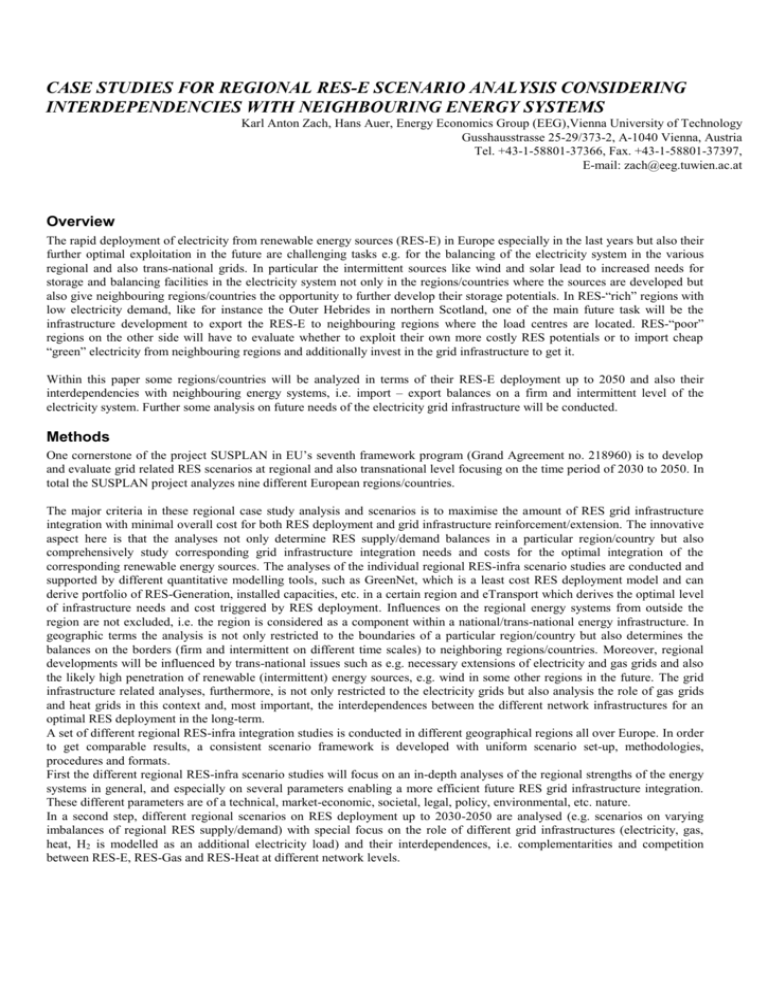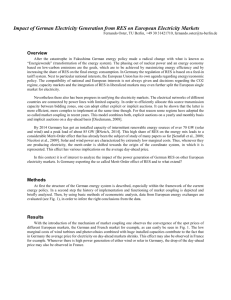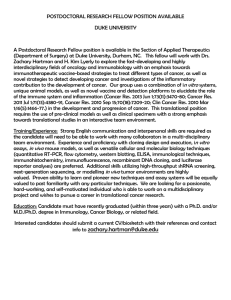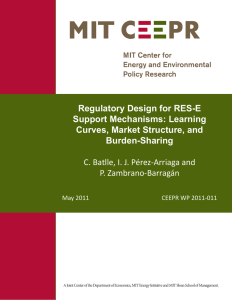Overview
advertisement

CASE STUDIES FOR REGIONAL RES-E SCENARIO ANALYSIS CONSIDERING INTERDEPENDENCIES WITH NEIGHBOURING ENERGY SYSTEMS Karl Anton Zach, Hans Auer, Energy Economics Group (EEG),Vienna University of Technology Gusshausstrasse 25-29/373-2, A-1040 Vienna, Austria Tel. +43-1-58801-37366, Fax. +43-1-58801-37397, E-mail: zach@eeg.tuwien.ac.at Overview The rapid deployment of electricity from renewable energy sources (RES-E) in Europe especially in the last years but also their further optimal exploitation in the future are challenging tasks e.g. for the balancing of the electricity system in the various regional and also trans-national grids. In particular the intermittent sources like wind and solar lead to increased needs for storage and balancing facilities in the electricity system not only in the regions/countries where the sources are developed but also give neighbouring regions/countries the opportunity to further develop their storage potentials. In RES-“rich” regions with low electricity demand, like for instance the Outer Hebrides in northern Scotland, one of the main future task will be the infrastructure development to export the RES-E to neighbouring regions where the load centres are located. RES-“poor” regions on the other side will have to evaluate whether to exploit their own more costly RES potentials or to import cheap “green” electricity from neighbouring regions and additionally invest in the grid infrastructure to get it. Within this paper some regions/countries will be analyzed in terms of their RES-E deployment up to 2050 and also their interdependencies with neighbouring energy systems, i.e. import – export balances on a firm and intermittent level of the electricity system. Further some analysis on future needs of the electricity grid infrastructure will be conducted. Methods One cornerstone of the project SUSPLAN in EU’s seventh framework program (Grand Agreement no. 218960) is to develop and evaluate grid related RES scenarios at regional and also transnational level focusing on the time period of 2030 to 2050. In total the SUSPLAN project analyzes nine different European regions/countries. The major criteria in these regional case study analysis and scenarios is to maximise the amount of RES grid infrastructure integration with minimal overall cost for both RES deployment and grid infrastructure reinforcement/extension. The innovative aspect here is that the analyses not only determine RES supply/demand balances in a particular region/country but also comprehensively study corresponding grid infrastructure integration needs and costs for the optimal integration of the corresponding renewable energy sources. The analyses of the individual regional RES-infra scenario studies are conducted and supported by different quantitative modelling tools, such as GreenNet, which is a least cost RES deployment model and can derive portfolio of RES-Generation, installed capacities, etc. in a certain region and eTransport which derives the optimal level of infrastructure needs and cost triggered by RES deployment. Influences on the regional energy systems from outside the region are not excluded, i.e. the region is considered as a component within a national/trans-national energy infrastructure. In geographic terms the analysis is not only restricted to the boundaries of a particular region/country but also determines the balances on the borders (firm and intermittent on different time scales) to neighboring regions/countries. Moreover, regional developments will be influenced by trans-national issues such as e.g. necessary extensions of electricity and gas grids and also the likely high penetration of renewable (intermittent) energy sources, e.g. wind in some other regions in the future. The grid infrastructure related analyses, furthermore, is not only restricted to the electricity grids but also analysis the role of gas grids and heat grids in this context and, most important, the interdependences between the different network infrastructures for an optimal RES deployment in the long-term. A set of different regional RES-infra integration studies is conducted in different geographical regions all over Europe. In order to get comparable results, a consistent scenario framework is developed with uniform scenario set-up, methodologies, procedures and formats. First the different regional RES-infra scenario studies will focus on an in-depth analyses of the regional strengths of the energy systems in general, and especially on several parameters enabling a more efficient future RES grid infrastructure integration. These different parameters are of a technical, market-economic, societal, legal, policy, environmental, etc. nature. In a second step, different regional scenarios on RES deployment up to 2030-2050 are analysed (e.g. scenarios on varying imbalances of regional RES supply/demand) with special focus on the role of different grid infrastructures (electricity, gas, heat, H2 is modelled as an additional electricity load) and their interdependences, i.e. complementarities and competition between RES-E, RES-Gas and RES-Heat at different network levels. Expected Results This paper focus on the analyzes of some selected regions/countries of the SUSPLAN project. Most important outcomes to be derived by the modelling activities of the regional scenario studies describe RES related parameters inside and on the borders of the region. Selected examples are e.g.: Portfolio of regional RES generation (firm, intermittent) generated and consumed in the region within different scenarios up to 2050. Corresponding network (electricity, gas, heat grids) and network integration technology (e.g. storage, load response, etc.) needs and cost in the region enabling the absorption of RES generation in the different scenarios up to 2050. RES related balances on the regional borders, e.g. RES related import/export balances (firm/intermittent) on the regional borders1 and, furthermore, also rough estimation on cross-border network and network integration technology needs and cost to other regions (a detailed analyses in this context is one of the core objectives of another work package of the SUSPLAN project). Besides the above mentioned major results derived in the regional scenario studies (see also Figures 1 and 2 below) also a variety of other quantitative and qualitative results (like balancing and storage strategies in/outside the region, CO 2 emissions, security of supply aspects, etc.) are derived in several of the different regional scenario studies. Figure 2 - Grid infrastructure costs (electricity-, gas-, heat-grids) caused by RES integration and depending on the share of RES generation and RES-related imports/exports for the years 2030, 2040 and 2050 *RES-T (transport sector) is not subject of comprehensive analyses in the SUSPLAN project. Figure 1 - Portfolio of regional RES generation and RESrelated import/export balances (firm; intermittent; for different time scales) on the regional borders up to 2050 Conclusions This paper will give recommendations for the future development of RES-E in Europe by analyzing some selected individual European regions in terms of i.e. their RES-E deployment up to 2050 and also their import – export balances on a firm and intermittent level of the electricity system/market. 1 Selected examples of cross-border RES balances to be studied in detail are e.g. ocean and/or offshore-wind energy from the Atlantic Ocean and the North Sea transported to load centers in UK and Central Europe or solar energy from Africa to the load centers in Central Europe.





